Writing Boxes Stand the Test of
Time
by
Bob Brooke
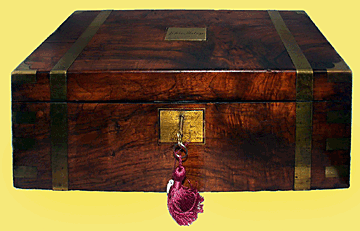 One
of the delights of collecting old things is to be able to use the
object for its original purpose. Such is the writing box. It can be
used to contain correspondence and stamps or to organize monthly
bills. Unfortunately, in this age of hi-tech wizardry, people write
few letters and the writing box has fallen out of use. One
of the delights of collecting old things is to be able to use the
object for its original purpose. Such is the writing box. It can be
used to contain correspondence and stamps or to organize monthly
bills. Unfortunately, in this age of hi-tech wizardry, people write
few letters and the writing box has fallen out of use.
Writing boxes date back to the beginning of writing. Monks used
boxes, called scriptoriums, in the Middle Ages. Eventually,
craftsmen mounted these on stands and later added legs, creating the
first desks for doing illuminated manuscripts. The writing box,
which came much later, survived through the 19th century.
From the end of the 18th to the end of the 19th century, the writing
box featured prominently on military expeditions, travels, libraries
and in drawing rooms. People wrote dispatches, contracts, letters
and postcards on their sloping surfaces.
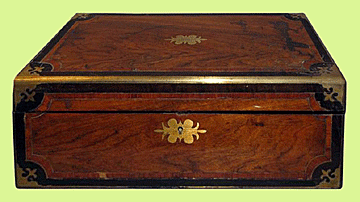 Prior
to 1780, the only portable writing devices were inkstands, writing
sets, oak Bible boxes, and sloping writing boxes. These were
rectangular and had sloping tops which were less steep than the
earlier Bible boxes. They also had side drawers for paper and spaces
for containers of ink and sand. Prior
to 1780, the only portable writing devices were inkstands, writing
sets, oak Bible boxes, and sloping writing boxes. These were
rectangular and had sloping tops which were less steep than the
earlier Bible boxes. They also had side drawers for paper and spaces
for containers of ink and sand.
After 1780, merchants began using writing boxes for business, and
the tops became flat in order to make traveling with them easier.
The production of suitable glazed writing paper and the improvement
of writing materials, together with the introduction of organized
postage led to the popular demand for the personal writing box.
Construction Materials
In general writing boxes came in two types—those that looked like a
rectangle when closed and those that formed a slope when closed. All
featured a top that opened to reveal a removable compartment tray
for storing inkwells, pens, sand, seals and wax. Under the tray was
a hinged and folded surface for writing which, when opened, provided
ample space for the writer to work. Makers of writing boxes covered
the writing surface in velvet, felt, or tooled leather. A bottom
compartment, under the lid, provided space for storing papers and
letters.
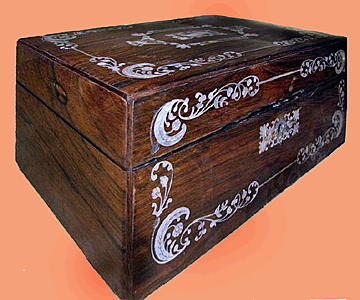 Writing
boxes came in all sizes and a variety of woods, including mahogany,
burl walnut, and rosewood. Cabinetmakers used calamander wood for
the more expensive ones. For the less expensive writing boxes,
craftsmen veneered exotic woods such as calamander and rosewood onto
a pine base. Marquetry, the delicate inlay of patterns of a lighter
color wood such as boxwood, was also common. The more ornate boxes
had brass ormolu mounts added to protect the corners from damage. Writing
boxes came in all sizes and a variety of woods, including mahogany,
burl walnut, and rosewood. Cabinetmakers used calamander wood for
the more expensive ones. For the less expensive writing boxes,
craftsmen veneered exotic woods such as calamander and rosewood onto
a pine base. Marquetry, the delicate inlay of patterns of a lighter
color wood such as boxwood, was also common. The more ornate boxes
had brass ormolu mounts added to protect the corners from damage.
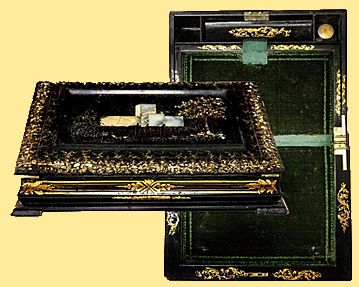 The
design of writing boxes reflected the changing fashions of the
times. More ornate boxes made of papier mache featured shimmering
mother-of-pearl inlay while delicate Sadeli Mosaic covered those
made in India. Deluxe boxes had velvet interiors while cheaper
models had laminated paper interiors with baize—the green felt-like
cloth used on billiard tables—covering their writing surfaces.
Writing boxes seldom had marks and only the type of wood and the
overall design gave a clues to their origin. The
design of writing boxes reflected the changing fashions of the
times. More ornate boxes made of papier mache featured shimmering
mother-of-pearl inlay while delicate Sadeli Mosaic covered those
made in India. Deluxe boxes had velvet interiors while cheaper
models had laminated paper interiors with baize—the green felt-like
cloth used on billiard tables—covering their writing surfaces.
Writing boxes seldom had marks and only the type of wood and the
overall design gave a clues to their origin.
Towards the end of the 19th century, makers often covered the
outsides and insides of their writing boxes with tooled leather in
burgundy red, midnight blue, or black. It wasn’t unusual for a
wealthier person to have their name engraved on the brass handle
plate.
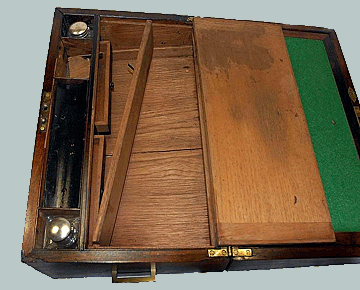 Makers
fitted writing box interiors with the necessary writer's
accessories—stationery, letters, pen-holders, quills, seals sealing
wax, ink and pounce—all had their separate holders or compartments.
Many had a secret drawer. Simpler tourist writing cases became
available in Moroccan leather, lined with satin, equipped with
everything but an inkwell. Makers
fitted writing box interiors with the necessary writer's
accessories—stationery, letters, pen-holders, quills, seals sealing
wax, ink and pounce—all had their separate holders or compartments.
Many had a secret drawer. Simpler tourist writing cases became
available in Moroccan leather, lined with satin, equipped with
everything but an inkwell.
The utility of an easily portable box to provide storage for writing
materials and a surface on which to write eventually led to the
continuing usage of a smaller and more compact box that became very
popular in the late 18th century. Known as lap desks, these writing
boxes were quite portable, so the user could hold it on his or her
lap or use it at a table. They came with lids, hinged at the front,
that slanted upwards towards the back, opening to form a writing
surface with only one compartment underneath for storage.
The Campaign Box
Army officers needed larger writing boxes, which could withstand the
rough and tumble of strenuous journeys. This gave rise to the most
popular type of 18th century writing box, the military style, or
campaign box, made of solid mahogany in a rectangular shape with a
flat surface. They were 8 to 20 inches long, 10 inches deep when
closed and 7 inches tall. They opened up to a sloping writing
surface consisting of two flaps with space under them for paper.
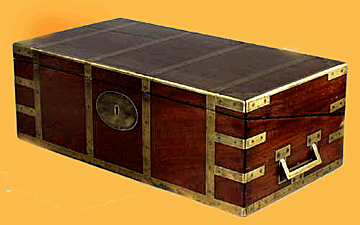 In
1790, cabinetmakers crafted campaign boxes of solid mahogany with
dovetail construction with brass strips wrapped around them for
extra support. When opened to the writing position, these boxes
contained a space for ink and sand wells, pens and quills in the top
part of the box. They often featured drop side handles and side
drawer, which followed the line of the slope, for storing papers.
Inside there was a sloping leather writing surface and other
compartments for papers and writing implements. Hidden behind a
panel might have been a nest of secret drawers. The box also has an
adjustable riser enabling it to be used as a reading stand. In
1790, cabinetmakers crafted campaign boxes of solid mahogany with
dovetail construction with brass strips wrapped around them for
extra support. When opened to the writing position, these boxes
contained a space for ink and sand wells, pens and quills in the top
part of the box. They often featured drop side handles and side
drawer, which followed the line of the slope, for storing papers.
Inside there was a sloping leather writing surface and other
compartments for papers and writing implements. Hidden behind a
panel might have been a nest of secret drawers. The box also has an
adjustable riser enabling it to be used as a reading stand.
By the early 1800s, writing boxes had become more popular due to the
popularity of traveling and the onset of the Napoleonic wars, during
which officers used them both for military business and for writing
to their families.
Captain's Boxes
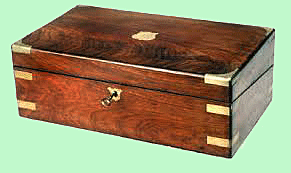 Similar and somewhat larger boxes began to appear on ships. Captains
usually had a writing box on board which had secret compartments and
a screw-down mechanism to keep everything in place as the ship
rolled on the waves. Of all the writing boxes at the time, this was
the most complex and intriguing. Each one differed in its
arrangement of secret compartments and drawers. Often the box
contained spaces for candlesticks and a reading stand. Similar and somewhat larger boxes began to appear on ships. Captains
usually had a writing box on board which had secret compartments and
a screw-down mechanism to keep everything in place as the ship
rolled on the waves. Of all the writing boxes at the time, this was
the most complex and intriguing. Each one differed in its
arrangement of secret compartments and drawers. Often the box
contained spaces for candlesticks and a reading stand.
Traveling Writing Boxes
Another type was triple opening writing box, made to open in two
directions, one part upwards, the other down. The middle and down
part form the two sections of the normal writing box. The upper part
opens as an upright lid with an attached leather covered container
and sometimes pockets for notes. It also featured two white writing
boards on its writing surface and a concave wooden pen holder.
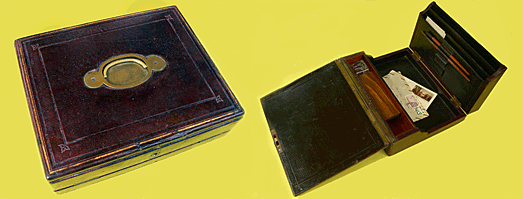
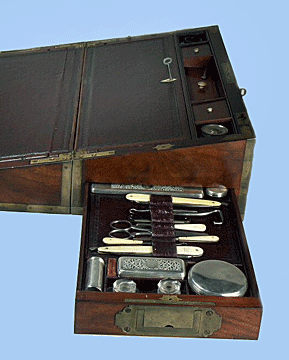 As the century progressed, well-to-do
young men took to traveling throughout Europe and the Middle East on
what became known as the Grand Tour. Some gentlemen’s writing boxes
contained space for toiletry items such as shaving, soap, and lotion
containers that they might require while traveling. While they
toured, they kept journals in which they recorded their impressions
and some made drawings of historic landmarks and objects.
Businessmen also traveled the globe in search of commercial and
trade opportunities. As the century progressed, well-to-do
young men took to traveling throughout Europe and the Middle East on
what became known as the Grand Tour. Some gentlemen’s writing boxes
contained space for toiletry items such as shaving, soap, and lotion
containers that they might require while traveling. While they
toured, they kept journals in which they recorded their impressions
and some made drawings of historic landmarks and objects.
Businessmen also traveled the globe in search of commercial and
trade opportunities.
From the end of the 18th, to the end of the 19th century, the
writing box featured prominently on military expeditions, travels,
libraries and in drawing rooms. Many people used them, from famous
writers like Charles Dickens and Lord Byron to merchants and
travelers.
Collecting Writing Boxes
Serious collectors of writing boxes tend to establish a theme
because of the many types available. This could be based on
material, size, or intended use. In addition, a specific collection,
such as writing boxes, has enormous value as a link with history.
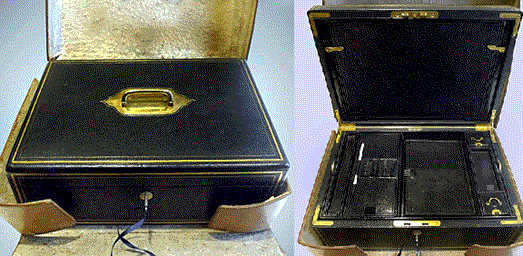
Since writing boxes were personal possessions, their condition is
often good today. But some show wear and tear, which can often be
easily repaired and restored. Restoring a writing box is far less
time consuming and expensive than doing the same to a large piece of
furniture.
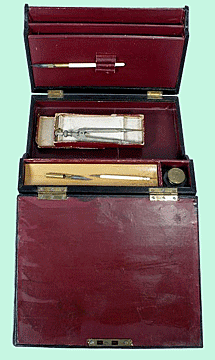 Simpler boxes can be found for anywhere from $50 to $750. English
antique writing boxes often sell for a lot more. However, most
antique dealers carry only one at a time because they're difficult
to sell unless a customer is a collector or has a personal use for
one. Simpler boxes can be found for anywhere from $50 to $750. English
antique writing boxes often sell for a lot more. However, most
antique dealers carry only one at a time because they're difficult
to sell unless a customer is a collector or has a personal use for
one.
Although quality, ornament and form did play an important part in
people’s selection of a writing box as a personal item, it’s the
purpose for which they used it which gave prominence to the writing
box, at a time of expanding intellectual curiosity, communication,
literacy and increased commercial activity. e they're difficult to
sell unless a customer is a collector or has a personal use for one.
To read
more of my articles, please
visit
my Web site.
<
Back to Antiques Articles
Next Article > |
